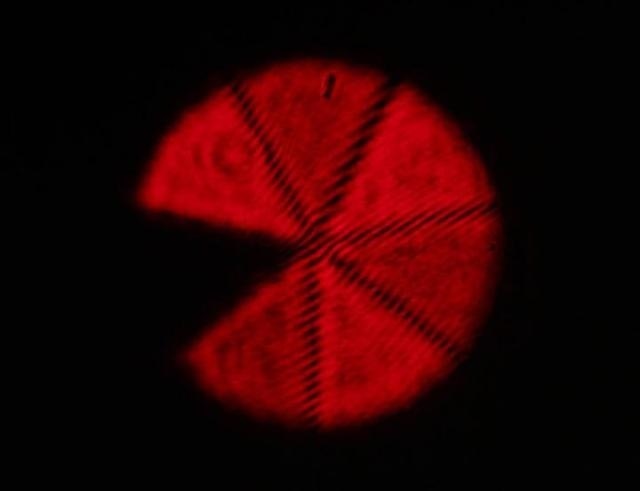Apr 4 2016
Researchers from the University of Rochester have succeeded in demonstrating a new technique to obtain a complete picture of twisted light, in order to characterize its Wigner distribution, despite a number of experimental challenges.
 To characterize twisted light the researchers looked at the images produced by the interference of a structured laser beam with a replica of that beam rotated by a given angle, including this "Pac-Man." (credit: Mohammad Mirhosseini)
To characterize twisted light the researchers looked at the images produced by the interference of a structured laser beam with a replica of that beam rotated by a given angle, including this "Pac-Man." (credit: Mohammad Mirhosseini)
Researchers find the concept of twisted light to be of immense interest because of its suitability for quantum communication applications. Orbital angular momentum (OAM) is a unique parameter of twisted light, making it look attractive to encode quantum information. A fundamental limit is not available to restrict the maximum OAM value that can be suitably coded into a photon, which increases the communication speed compared with other systems.
Researchers will first have to measure and explain a specific system before using it in quantum communication. Previously direct measurements or quantum tomography were used to obtain the wavefunction, which is a property that illustrates a whole quantum system. The researchers, in a recent article published in Physical Review Letters, highlighted that their method is appropriate for quantum information applications, where many different OAM states are involved.
The Wigner distribution helps to describe a system based on two conjugate variables, which refer to the two variables connected by Heisenberg's Uncertainty Principle. Mohammad Mirhosseini, a postdoctoral associate in Professor of Optics Robert W. Boyd's group, and his co-workers at the Institute of Optics, have highlighted in their work the way to obtain the Wigner distribution for twisted light. The researchers also characterized the Wigner distribution involving a discrete variable, similar to OAM, for the first time.
Apart from the potential uses in quantum communication, our work might offer a good way for describing atomic systems with quantized levels. The Wigner distribution of twisted light is a very complete way to understand the system: not only does it tell us about the relation between these two linked variables, but it also tells us about the system's behavior. We showed that the Wigner distribution for twisted light superpositions contains negative values, which reveals wave-like behavior.
Mohammad Mirhosseini, Postdoctoral Associate, Institute of Optics, University of Rochester
Mirhosseini believes that this discovery will lead to other future experiments.
Measuring time in quantum systems is not as simple as using a watch - it can prove challenging. The conjugate variable of OAM, angle, is in many ways similar to phase, which is itself similar to time. So perhaps the lessons learned here can be applied, in other experiments, to systems where we need to measure time.
Mohammad Mirhosseini, Postdoctoral Associate, Institute of Optics, University of Rochester